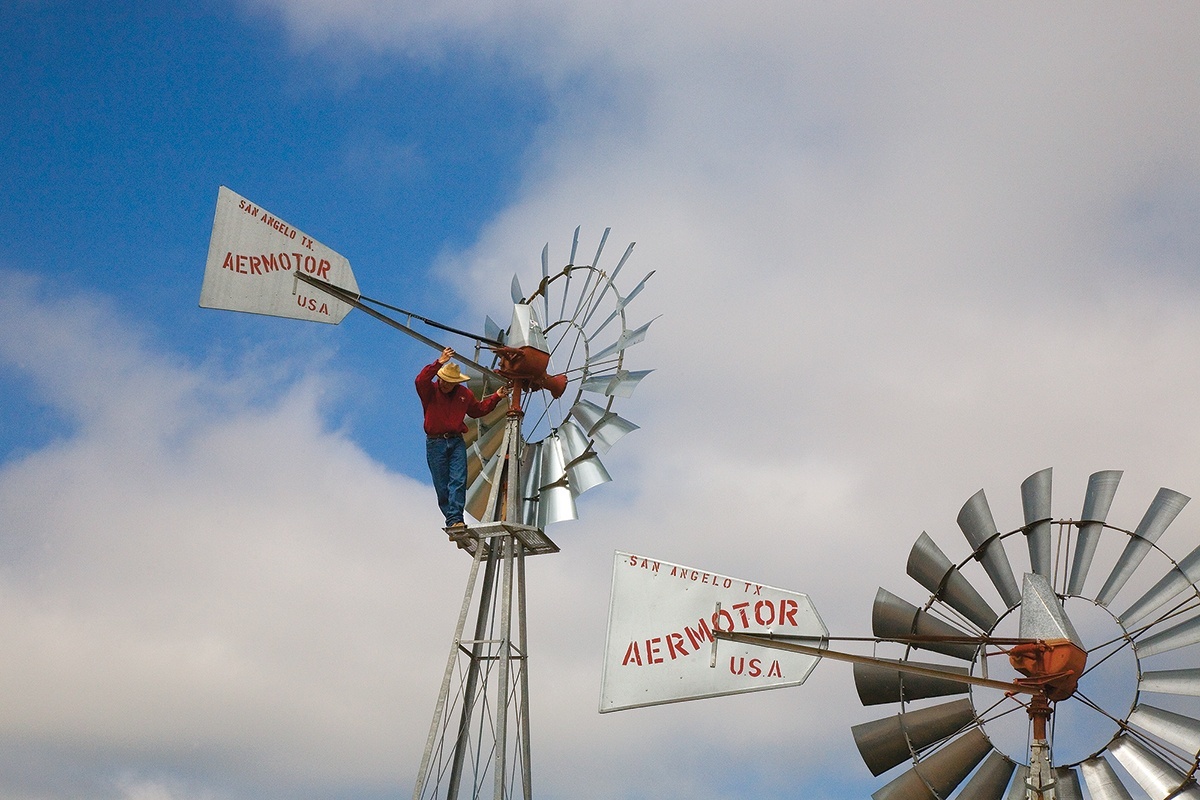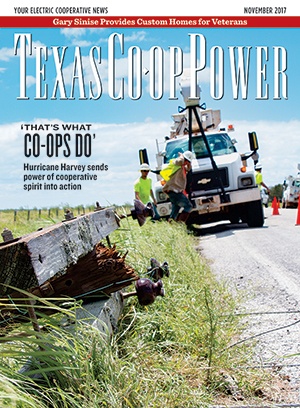Nature works for nothing,” an 1898 windmill advertisement reads. Windmillers, however, do not. As long as windmills continue to work across the ranchlands of West Texas, so will the windmillers who climb the towers, lubricate the mills, tighten the brakes, repair the sails, pull the pumps and couple the rods.
The windmiller and the windmill go hand-in-hand, much the same way that wind and water together make agriculture and ranching possible in arid lands. Perhaps that’s why a windmill is often named for its windmiller, typically the same person who drilled its well.
Examine a topographic map of the West Texas grasslands from Sanderson to Van Horn, and you’ll see the names of mountain humps and hilly bumps like Santiago, Elephant and Cathedral, along with railroad watering stations like Tesnus (sunset spelled backward). In between, you’ll find poetry in windmill names—the Starr, Beakeley, Syl and Wagner—tiny markers in a vast sea of grass, testimonies to lives long passed.
“Windmiller” might seem like an odd job title to city dwellers, but landowners continue to employ water well drillers and windmillers. In fact, windmillers have their own quarterly newsletter, Windmillers’ Gazette, in print for more than 35 years.
Today’s self-governing windmill is the invention of New England mechanic Daniel Halladay. Wind power was the rage in the 1850s, inspiring more than 50 patents for windmills and windmill improvements.
But it was Halladay who designed the first windmill that ran without human intervention, turning automatically to face the wind and governing its own speed to avoid self-destruction by centrifugal force.
Constructed primarily of wood with iron wheel arms, the Halladay Standard windmill faced the wind with the aid of a rigid vane, much like a weathervane, turning the blades to face the wind at the optimal angle for maximum power. If the wind made the wheel turn too fast, a centrifugal governor altered the wheel’s position, exposing less blade surface to the wind. The wheel also could be positioned parallel to the wind, ensuring that the wheel wouldn’t turn at all in high winds.
In another Halladay design, called a sectional-wheel windmill, the wheel was composed of blade sections that pivoted, modifying the amount of surface exposed to the wind, opening and closing with the wind speed like an umbrella. These vaneless mills used a counterweight system to keep the wheel facing the wind. The weights were whimsically shaped as well as functional: cast metal in the shapes of roosters, draft horses, squirrels, cows, bulls, footballs and even battleships.
The Rev. Leonard H. Wheeler improved Halladay’s design with the Eclipse windmill. The Eclipse introduced the vane-and-wheel combination windmill we see today. A rigid wheel modified its wind angle using a hinged vane that moved rather than a fixed vane like the Halladay Standard.
Between 1854 and 1920, more than 700 companies manufactured thousands of windmills in the U.S.; of those, only Aermotor Windmill Company is left. Aermotors are the most recognizable today. Their water-lifting power and smooth pumping action made them the favored windmill of pioneers as they moved west and of the railroads, in need of water for their boilers as they crisscrossed the country.
In 1915, Aermotor introduced the auto-oiled windmill, a dramatic change in both the windmill design and the priorities of the windmiller’s schedule. With the innovation, the windmill motor required a once-a-year oil change rather than weekly maintenance. The improvement was simple. Aermotor enclosed all the working parts in a gearbox, where gears could bathe constantly in a lightweight lubricating oil.
A significant increase in steel manufacturing throughout the first half of the 20th century along with the rise of mass production enabled Aermotor to convert its wooden windmill inventory to steel. Then, in 1933, the company introduced the Aermotor 702. The 702 enabled the windmiller to replace worn-out bearings, key parts in a self-governing device. Since then, Aermotor has dominated the American windmill market.
Aermotor’s journey started in Chicago in 1888 with LaVerne Noyes, an inventor familiar with the rudiments of manufacturing. The company grew so rapidly that, by 1904, the factory covered several acres. With mass production in place, Aermotor could drop windmill prices to about one-sixth of the original cost, selling 8-foot windmills for around $25. An 8-footer will typically pump 180 gallons of water an hour in 15–20 mph winds, raising the water approximately 175 feet from an underground well, the average water table depth in Texas.
Today, the Aermotor Windmill Company, owned by Texans, operates out of San Angelo and continues to sell a lot of windmills. The Aermotor remains perhaps the most efficient and economically viable way to bring water to the surface, particularly because the wind is free.
Ironically, wind is also often the source of a windmill’s demise. Strong wind currents and storms collapse towers, shear blades and wrap tailbones around gearboxes. But even a twisted windmill is a thing of beauty. Form transcends function, illustrating the poetic truth for both wind and windmill found in another ad from the 1800s that reads, “Her forces are never exhausted.”
——————–
E. Dan Klepper is a photographer, author and artist who lives in Marathon.


